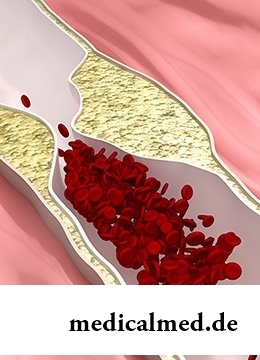





Portal hypertensia
 Portal hypertensia is a disturbance of a normal blood flow in portal vessels, a hepatic and lower vena cava which leads to the increased hydrostatic pressure in a portal vein. This disease occurs both at adults, and at children, and arises most often because of cirrhosis. It can be followed by a varicosity of a stomach and gullet, a splenomegaly, ascites, disturbances of coagulability of blood towards hypocoagulation and other symptoms and syndromes.
Portal hypertensia is a disturbance of a normal blood flow in portal vessels, a hepatic and lower vena cava which leads to the increased hydrostatic pressure in a portal vein. This disease occurs both at adults, and at children, and arises most often because of cirrhosis. It can be followed by a varicosity of a stomach and gullet, a splenomegaly, ascites, disturbances of coagulability of blood towards hypocoagulation and other symptoms and syndromes.
Gastrointestinal bleedings and hepatic coma – the most dangerous complications of portal hypertensia of a liver.
Etiology of portal hypertensia
The syndrome of portal hypertensia is not an independent disease, but clinical displays of various pathologies according to which nature distinguish dopechenochny, intra hepatic and post-hepatic types of portal hypertensia.
Treat a prehepatic form:
- Congenital anomaly of development of a portal vein;
- Fusion of a gleam of all vein or its certain site;
- Pressure upon veins tumorous or inflammatory infiltrate and cysts;
- Mechanical injuries of a portal vein;
- Liver operations.
Practically all existing acute and chronic diseases affecting this body can be the reasons of internal portal hypertensia of a liver:
- Primary biliary cirrhosis;
- Sclerous scarring of hepatic fabric;
- Pseudorheumatism;
- Acute alcoholic hepatitis;
- Felti's syndrome;
- Inborn fibrosis of a liver;
- Wilson's disease;
- Karoli's disease;
- Disease to Gosha;
- Alveococcosis;
- Hemochromatosis;
- Schistosomiasis;
- Sarcoidosis;
- Liver polycystosis;
- Tumors;
- Myeloproliferative diseases;
- Intoxication vitamin A;
- Reception of medicines;
- Intoxication vinyl chloride, arsenic, copper.
Portal hypertensia of post-hepatic type is caused by blocking of blood in liver veins for the following reasons:
- Kiari's disease – full or partial obstruction of veins;
- Thrombosis of the lower vena cava – a tumor and a cyst;
- Disturbances of cordial activity – insufficiency of the tricuspid valve, chronic cardial compression.
Symptoms of portal hypertensia
Symptoms of portal hypertensia are connected with primary disease which served as the reason of high pressure in system of a portal vein.
The prehepatic form arises in the childhood more often and in general has the favorable forecast. Most often it is followed by bleedings from esophageal veins, a splenomegaly, a hypersplenism, thrombosis of a portal vein. At some patients the portal vein is replaced with network of small expanded veins.
Symptoms of cirrhosis are characteristic of intra hepatic type of portal hypertensia. The course of a disease depends on to what look cirrhosis (atrophic, postnecrotic, biliary or pigmental), and also from extent of compensation of dysfunctions of a liver and activity of pathological process belongs. Patients have hemorrhagic complications, a splenomegaly, a phlebectasia of a front abdominal wall, ascites. Expanded veins are subject to the gaps leading to bleeding. At the same time there is vomiting blood without pain in epigastriums. If blood flows into a stomach, then vomiting has color of a coffee thick. Quickly posthemorrhagic anemia develops. The first bleeding from gullet veins in 30% of cases terminates in a lethal outcome. At the started cirrhosis damage to a parenchyma of a liver is caused by ascites and a disease of the Gospel. In these cases both conservative, and operational treatment of portal hypertensia can not be crowned with success.
The post-hepatic form of a syndrome in an acute stage is followed by severe pain in right hypochondrium and epigastric area. Quickly the hyperthermia, a hepatomegalia and ascites accrues. Death is caused by a baked renal failure and profuse bleedings from esophageal veins. In a chronic stage of a disease the hepatomegalia and a splenomegaly develop gradually. On a front abdominal wall the collateral venous network appears. Exhaustion and a hypoalbuminemia (disturbance of protein metabolism) is observed.
Diagnosis and treatment of portal hypertensia
Diagnosis of a syndrome of portal hypertensia is carried out by the hepatologist, the gastroenterologist or the oncologist by means of ultrasound examination of an abdominal cavity. It shows increase in a spleen and liver, and also reveals accumulation of liquid and change of diameter of a portal and splenic vein.
At suspicions of portal hypertensia carrying out a fibrogastroduodenoskopiya (FGDS) is necessary for assessment of a condition of veins of a gullet and detection of gastrointestinal bleeding. The varicosity of digestive tract is established by means of a contrast X-ray analysis. Except the specified researches the general analysis of urine and biochemical analysis of blood is carried out.
 Treatment of portal hypertensia can be conservative or surgical. It is directed, first of all, to elimination of an initial disease and prevention of bleeding in digestive tract.
Treatment of portal hypertensia can be conservative or surgical. It is directed, first of all, to elimination of an initial disease and prevention of bleeding in digestive tract.
Some doctors use nitrates and beta-blockers, but most often resort to operations, especially at ascites, the expressed liver failure and rapid expansion of gastric veins. Surgical intervention consists in creation of new ways for outflow of blood and in removal of liquid of an abdominal cavity. At the same time it is important to regulate the process speed as at intensive dehydration the hepatic coma can develop. In some cases liver transplantation is necessary.
Portal hypertensia does not recover completely. Any methods give only temporary effect, and the disease in most cases is returned. But without treatment the term of life of patients is sharply reduced and averages 1,5 years. Therefore the correct therapy of diseases of a liver and timely diagnosis of portal hypertensia is extremely important.
Most of women is capable to derive more pleasure from contemplation of the beautiful body in a mirror, than from sex. So, women, you aim at symmetry.

You heard that laughter prolongs life? To establish longevity direct link with sincere fun to researchers yet not удалос...
Section: Articles about health
There comes the season of issues. Many Russians already dream of outdoor recreation, trips, beautiful seaside beaches. At this time there is no wish to think of problems with health and other unpleasant things, however there are subjects which require attention. Summer...
Section: Articles about health
Health and attractiveness - eternal values, pursuing which people often use the most unusual ingredients and technicians. Let's consider 11 most exotic and sometimes not most pleasant Spa procedures to which the person in a pursuit of beauty and youth agrees....
Section: Articles about health
The list of stereotypes of which, apparently, all know strongly includes following: British surely eat for breakfast овсянк...
Section: Articles about health
The number of long-livers is very small. One person from 5 thousand lives up to age of 90 years, and the centenary boundary steps over only one of 20 thousand. However, doctors claim that each of us is quite able to affect own destiny. At the same time speech to Ida...
Section: Articles about health
Extracorporal fertilization – one of the most modern methods of controlling with infertility. So far he already helped a significant amount of married couples to become happy parents. Usually to the EKO procedure difficult and very expensive, resort in those situations when all other ways to help couple to bring the child are inefficient. "Conception in a test tube" yields quite good results in cases of infertility of one of partners, existence at the woman of impassability of uterine tubes...
Section: Articles about health
The depression not without reason is considered one their main troubles of our century: for scientific and technical progress, acceleration of rate of life and a surplus...
Section: Articles about health
The popular expression "run from a heart attack" became the motto of the people supporting active lifestyle. Moreover, run became a peculiar fashionable tendency: sales of racetracks and the accompanying goods for run are at permanently high level. Really...
Section: Articles about health
According to data of World Health Organization, the cataract is diagnosed almost for 7% of the population of Earth. The statistics of incidence is considered not full as at an initial stage the illness, as a rule, does not cause to the person of special inconveniences, and many diseased sees doctors not at once. The cataract is not only one of the most widespread ophthalmologic illnesses, but also the reason of a half of cases of loss of sight....
Section: Articles about health
Several decades ago the basil (the district khan, реан, Reagan) was considered as a part of the Caucasian or east cuisine, but today it is strong for...
Section: Articles about health
Memory is an ability of the central nervous system to fix, keep and as necessary to reproduce information on knowledge or skills received by the person or an animal during life. The mechanism of this process is up to the end not studied....
Section: Articles about health
Frosty air, fresh wind and easy snowball at most of Russians are associated with cheerfulness, health and cheerful entertainments on which our winter is so generous. But, unfortunately, cold season sometimes brings also troubles with health. It is not about seasonal colds and frostbites, and about those chronic illnesses which symptoms are shown preferential in the winter....
Section: Articles about health
One of the major chemical processes happening in a human body are oxidation reactions. They go with participation of fats...
Section: Articles about health
Vitamin complexes belong to the most popular drugs, probably, in our country there is no person who was not hearing about advantage of vitamins and never their accepting. The more vitamins, the better, we consider and as it appeared, cruelly we are mistaken. So l...
Section: Articles about health
The drugs stopping or oppressing life activity of pathogenic microorganisms are widely applied in clinical practice from 40th years of the last century. Originally antibiotics were called only substances natural (animal, vegetable or microbic) origins, but over time this concept extended, and it includes also semi-synthetic and completely artificial antibacterial drugs....
Section: Articles about health
The body of the person almost for 60% consists of water. It is so important for normal functioning of an organism that loss of all is ponut...
Section: Articles about health
Scientists always aimed to offer fundamental explanations for medical problems. Their theories formed the basis of modern methods of treatment of the hardest pathologies and helped to save a set of lives. However stories are known also such theoretical constructions, following to...
Section: Articles about health
Milk and products of its processing by right occupy one of the main places in a diet of the modern person. They contain proteins, necessary for normal life activity, fats, vitamins and microelements, and are an important part of various medical diets....
Section: Articles about health
The stroke is one of the most widespread diseases of the person, annually in the world about 6 million cases эт are registered...
Section: Articles about health
Dietary supplements (dietary supplements) for the last decades were so thoroughly included into our life that, apparently, it is already impossible to find the person who at least once did not try them. At the same time, most of our compatriots have a vague idea about...
Section: Articles about health
The technique of acupuncture (acupuncture) is used in the medical purposes more than three and a half millennia. It is eurysynusic and recognized as official medicine in the majority of the developed countries of the world. Influence by fine needles on so-called points of acupuncture contributes to normalization of a metabolism and hormonal background, activates protective forces of an organism, has anesthetic and antiinflammatory effect, stabilizes a condition of mentality....
Section: Articles about health
All of us, unfortunately, should face flu nearly an every year. It would seem, so frequent disease has to be study...
Section: Articles about health
The way of life of people promptly changes from year to year: if about ten years ago the personal computer was not in each family, then today already very few people do without this device. Certainly, and children master the computer at full speed: they not only I play...
Section: Articles about health
The name of this disease precisely reflects the problem reason: it consists in the bra fastener pressure upon a certain zone of a back. At the same time one of vertebrae of chest department of a backbone is as if blocked and loses mobility, and the loading falling on it is distributed on the next vertebrae. At 70-80% of women local pains in a backbone point on which the fastener of the often put most on bra presses result....
Section: Articles about health
What will only not be thought up by persons interested to have a beautiful figure. Here the last innovation – for weight loss needs to be eaten greasy food. Give ра...
Section: Slideshow
The main role in development of a peptic ulcer of a stomach and duodenum the bacterium Helikobakter plays pilor. Activity and the strengthened reproduction of this microorganism lead to weakening of protection of mucous membranes and their erosive damage. Manifestations not...
Section: Articles about health
What woman does not dream of a beautiful and thick hair? While physicians developed difficult schemes on hair transplant, in the industry of hairdresser's art a few years ago there was a sensation – methods of hair extension appeared. It would seem, dreams came true: though the procedure of building also does not belong to the category cheap, practically any woman can increase several times the volume of hair, change their length and color – generally, to become the real beauty queen....
Section: Articles about health
